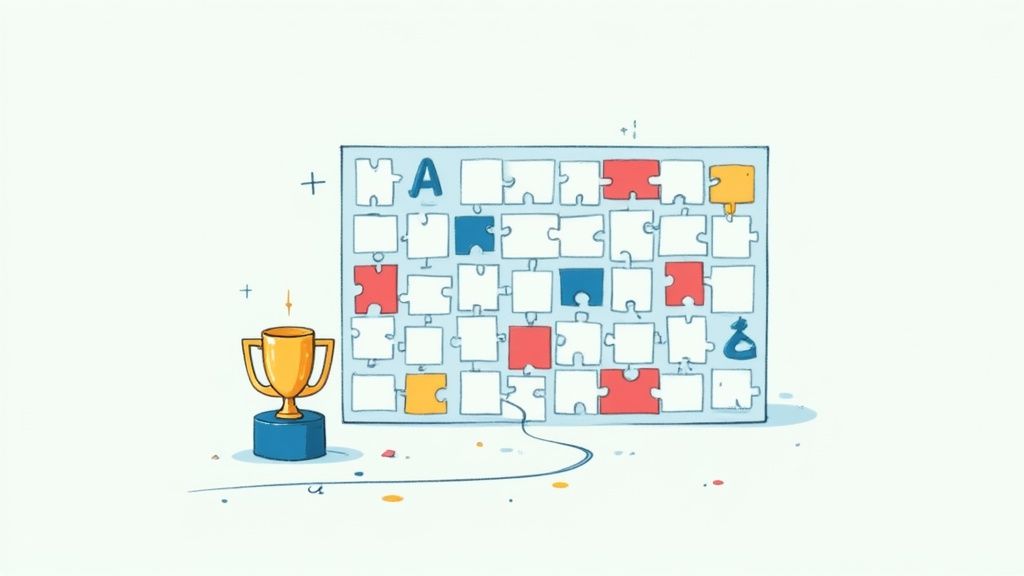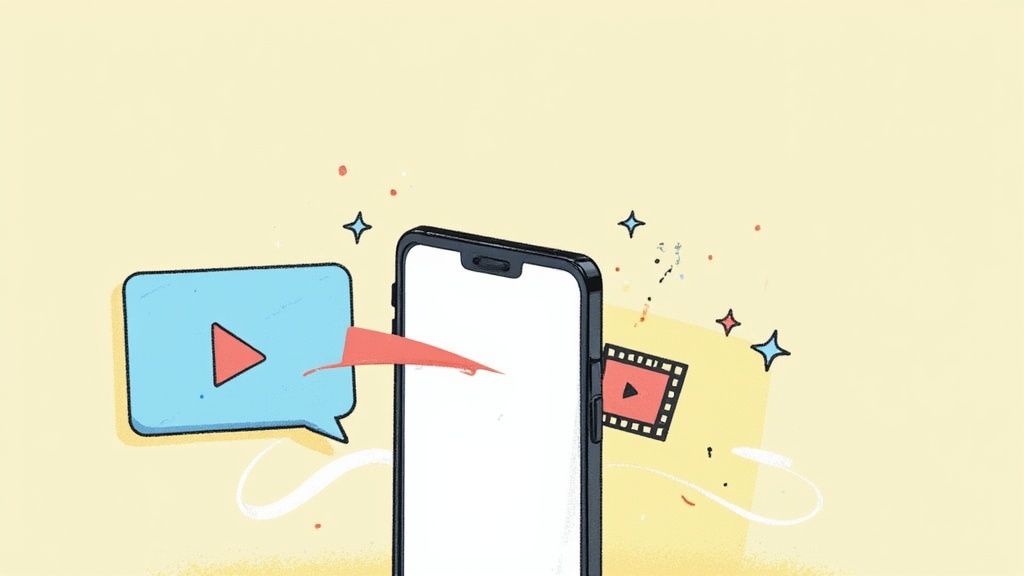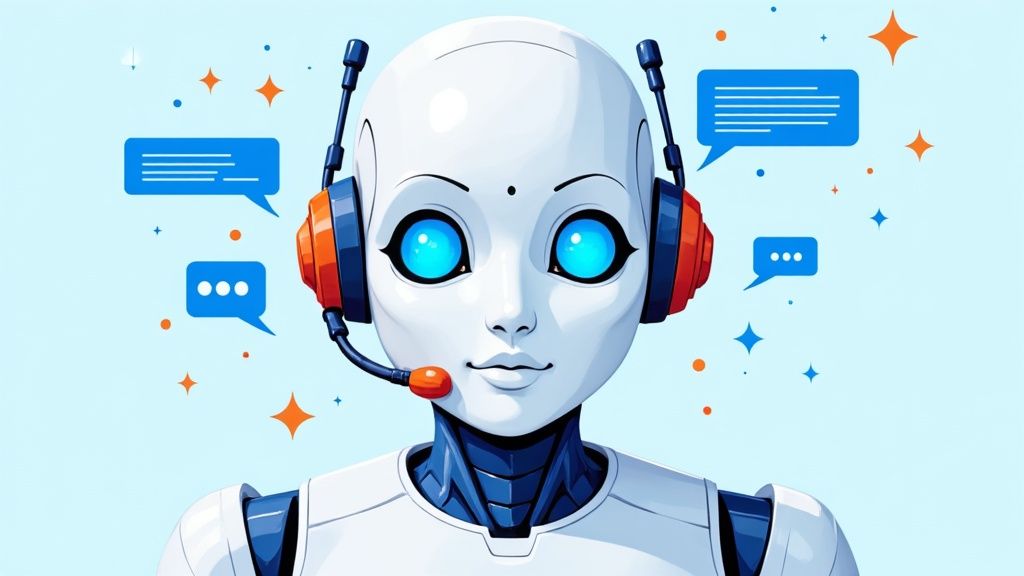
In the competitive 2025 talent market, traditional recruiting methods are falling short. Posting a job ad and waiting for applications is a passive strategy that often overlooks the best candidates, many of whom are not actively looking. To attract innovative thinkers and top performers, companies must adopt a proactive, engaging, and memorable approach. This means moving beyond standard interviews and embracing strategies that showcase your company culture while assessing skills in practical ways.
A positive candidate experience from the very first touchpoint is essential. In this guide, we'll explore nine creative recruiting ideas that can help you build a robust talent pipeline, reduce time-to-hire, and secure the professionals who will drive your business forward. These aren't just trendy tactics; they are strategic shifts that deliver tangible results in a modern, candidate-driven world. You will learn how to implement methods ranging from gamified challenges and VR experiences to podcasting and micro-internships to find your next great hire.
Move beyond traditional interviews with one of the most engaging creative recruiting ideas: gamified recruitment challenges. This approach transforms the typically stressful application process into an interactive experience. It uses games, puzzles, or simulations to assess a candidate's practical skills, problem-solving capabilities, and even their alignment with your company culture in a low-pressure, dynamic way.

This method provides a more accurate prediction of on-the-job performance than a resume alone. For example, Marriott International successfully used its "My Marriott Hotel" Facebook game to attract and evaluate candidates for hospitality management roles by having them manage a virtual hotel. Similarly, Google’s famous Code Jam competition helps them identify top engineering talent globally through complex algorithmic puzzles.
Tap into your most valuable resource, your current employees, with one of the most effective creative recruiting ideas: a structured employee advocacy and referral program. This strategy transforms your team into authentic brand ambassadors and talent scouts. It leverages their professional networks and trusted voices to attract high-quality candidates who are often a better cultural fit and tend to stay longer.

This approach goes beyond just asking for names; it systematizes the process to yield consistent results. For instance, Salesforce aligns its referral program with its V2MOM goal-setting framework, ensuring referrals directly support business objectives. Similarly, Intel famously used a "circuit breaker" program that doubled referral bonuses for high-priority roles, successfully accelerating hiring for critical positions. These programs boost morale and are central to maintaining a strong company culture, which is vital for both in-office and remote teams. You can find more inspiration with these remote employee engagement ideas.
Shift your strategy from active sourcing to passive attraction with one of the most sustainable creative recruiting ideas: building social media talent communities. This method involves creating and nurturing dedicated online spaces on platforms like LinkedIn, GitHub, or even niche forums where potential candidates can engage with your brand, share insights, and connect with your team long before a job opening is even posted. It’s a long-term play focused on relationship building over immediate hiring.

This proactive approach establishes your company as a thought leader and a desirable place to work. For instance, IBM actively engages with developers on platforms like GitHub and Stack Overflow, creating a vibrant community that serves as a rich talent pool. Similarly, HubSpot nurtures its inbound marketing community with valuable content, making it a go-to network for top marketing professionals. By investing in these communities, you cultivate a pipeline of pre-vetted, engaged candidates who are already aligned with your company's mission.
Elevate your employer brand with one of the most powerful creative recruiting ideas: video-first recruitment campaigns. This strategy moves beyond a single culture video, integrating authentic video content at every stage of the hiring funnel. From video job descriptions and virtual office tours to employee testimonials, this approach offers an immersive, transparent look into your company's environment, mission, and people.

Video-first strategies create a strong emotional connection that text-based job posts simply cannot match, helping attract candidates who genuinely resonate with your values. Tech giants like Shopify with its 'Life at Shopify' series and Spotify with its culture and diversity videos have masterfully used this method to build a compelling employer narrative. This approach showcases the human side of a company, making it feel more accessible and relatable to top talent worldwide.
Streamline your initial hiring stages with one of the most efficient creative recruiting ideas: AI-powered chatbot screening. This technology automates the preliminary vetting process by engaging candidates in real-time conversations. These intelligent bots can answer FAQs, ask screening questions, and even schedule interviews 24/7, providing instant engagement and a seamless candidate experience.
By handling high-volume, repetitive tasks, chatbots free up your recruitment team to focus on more strategic activities. For instance, L'Oréal uses its chatbot 'Mya' to interact with thousands of applicants, improving efficiency and candidate satisfaction. Similarly, Unilever's 'Unabot' helps manage initial applications, ensuring every candidate receives a timely response. These tools use machine learning to get smarter over time, enhancing the quality of interactions.
Take your employer brand into the future with one of the most immersive creative recruiting ideas: virtual reality (VR) recruitment. This innovative approach lets candidates step inside your world from anywhere. They can virtually tour your office, engage in job simulations, or experience your company culture firsthand, providing a realistic job preview that a simple description cannot match.
This high-tech method showcases your company as forward-thinking while giving candidates a powerful tool to make informed decisions. For example, Jaguar Land Rover used a VR app to engage potential engineers with code-breaking challenges and a virtual sports car experience. Similarly, Deutsche Bahn allows prospective train drivers to experience the role through a VR simulation, assessing their suitability for the demanding job in a safe, controlled environment.
Hosting hackathons and skill-based competitions is one of the most dynamic and effective creative recruiting ideas for sourcing top-tier talent. These high-energy events challenge participants to solve real-world business problems in a competitive, collaborative setting. It’s a powerful method for observing candidates' technical skills, creativity, and teamwork abilities in action, offering a far more authentic assessment than a standard interview.
This strategy serves the dual purpose of talent evaluation and powerful employer branding. For instance, JPMorgan Chase's Code for Good challenges students to build tech solutions for non-profits, showcasing the company's commitment to social impact while identifying promising developers. Similarly, Salesforce uses developer competitions at its TrailheaDX conferences to engage its community and recruit skilled professionals. These events generate excitement and position your company as an industry leader.
Tap into the power of audio with another of the most effective creative recruiting ideas: podcast and audio content recruitment. This strategy uses audio platforms to share authentic stories about your company culture, conduct interviews with employees, and discuss industry trends. It’s a powerful way to build thought leadership and connect with passive candidates during their commutes, workouts, or downtime when they are most receptive.
This method allows you to go beyond a job description and give potential hires an genuine feel for your workplace. For instance, Spotify’s "Work in Progress" podcast gives listeners a look inside the company’s culture and projects. Similarly, HubSpot’s "The Growth Show" provides valuable industry insights while subtly positioning the company as an exciting place to work for marketing and sales professionals.
Go beyond resumes and interviews with another of our top creative recruiting ideas: micro-internships and project-based trials. This approach offers candidates a short-term, paid work arrangement to tackle a specific, real-world business challenge. It gives both parties a low-risk opportunity to assess compatibility, work ethic, and practical skills before committing to a full-time role.
These trials, often lasting one to four weeks, provide a far more accurate gauge of performance than any interview question. Companies like Goldman Sachs run virtual insight programs to evaluate talent, while platforms like Parker Dewey specialize in connecting companies with college students for these short-term, professional assignments. This method lets you see a candidate’s skills in action, observing how they approach problems, collaborate with teams, and adapt to your company’s workflow.
| Recruitment Strategy | Implementation Complexity | Resource Requirements | Expected Outcomes | Ideal Use Cases | Key Advantages |
|---|---|---|---|---|---|
| Gamified Recruitment Challenges | High (game design & maintenance) | High (development & updates) | Engaged candidates, objective skill assessment | Tech-savvy roles, creative positions | Engages passive candidates; reduces time-to-hire |
| Employee Advocacy and Referral Programs | Moderate (platform & incentives) | Moderate (tools & rewards) | Higher quality hires, faster process | Organizations with strong culture | Lower cost-per-hire; better cultural fit |
| Social Media Talent Communities | Moderate to High (content & management) | Moderate (content creation) | Talent pipeline, brand awareness | Long-term hiring & employer branding | Cost-effective reach; two-way communication |
| Video-First Recruitment Campaigns | High (production expertise needed) | High (video production costs) | Increased engagement; emotional connection | Branding-focused recruitment campaigns | Better cultural representation; enhanced sharing |
| AI-Powered Chatbot Screening | High (technical setup & AI training) | Moderate (tech & integration) | Reduced workload; instant responses | High-volume screening processes | Consistent screening; cost-effective scaling |
| Virtual Reality Recruitment Experiences | Very High (technology & content) | Very High (VR hardware/software) | Memorable candidate experience; realistic previews | Innovative, tech-driven organizations | Differentiation; remote accessibility |
| Hackathons and Skill-Based Competitions | High (event planning & logistics) | High (mentors, prizes, organization) | Direct skill demonstration; cultural fit | Tech roles requiring hands-on skills | Innovation generation; multiple candidate evaluation |
| Podcast and Audio Content Recruitment | Moderate (content planning & production) | Low to Moderate (audio equipment) | Thought leadership; personal connection | Employer branding; storytelling | Low cost; commute-time accessibility |
| Micro-Internships and Project-Based Trials | Moderate (project setup & management) | Moderate (mentorship & admin) | Real work assessment; reduced hiring risk | Roles suited to project work | Creates talent pipeline; mutual evaluation |
The traditional "post and pray" method of recruiting is no longer enough to secure top-tier talent in today's competitive landscape. As we've explored, moving beyond standard job boards and embracing innovation is essential for standing out. From immersive VR experiences and gamified challenges to targeted social media communities and engaging video campaigns, the common thread is a commitment to building authentic connections and delivering a memorable candidate experience. These aren't just flashy gimmicks; they are strategic creative recruiting ideas designed to attract, engage, and accurately assess the skills of modern professionals.
The core takeaway is that a successful talent acquisition strategy is proactive, not reactive. It involves meeting candidates where they are, speaking their language, and offering them a genuine glimpse into your company's culture and values. The ideas presented, whether a skill-based hackathon or a micro-internship, shift the focus from a simple application to a meaningful interaction. This pivot is critical, as it allows you to evaluate practical skills and cultural fit far more effectively than a resume ever could.
So, where do you begin?
Ultimately, mastering these creative approaches is about more than just filling an open position. It’s about building a powerful employer brand and a sustainable talent pipeline that will fuel your company's growth for years to come. Start small, experiment, and learn what resonates with your ideal candidates. The future of your team depends on the creativity you bring to finding them.
